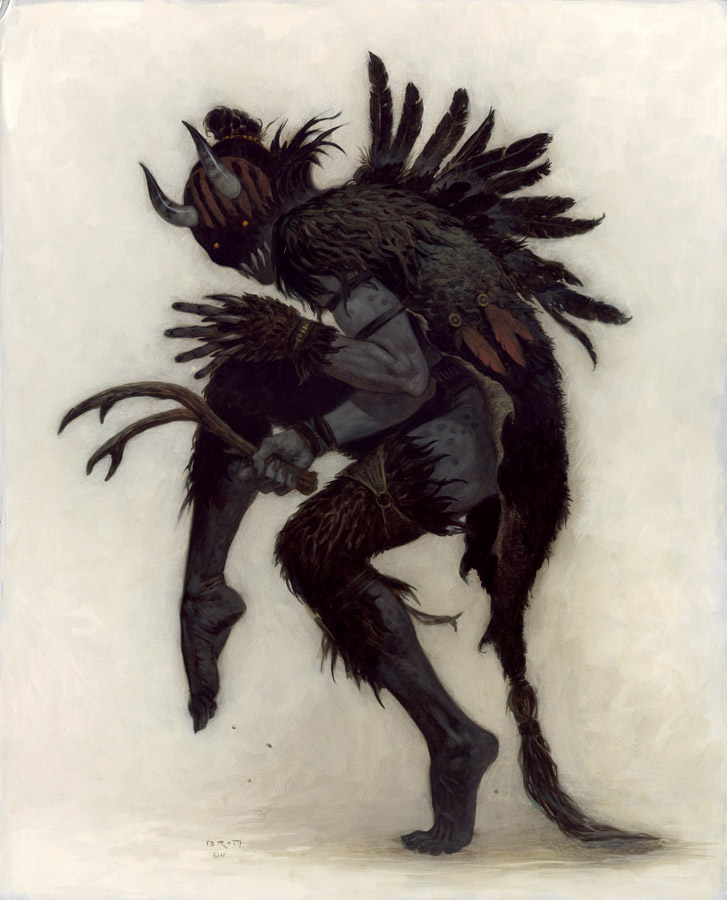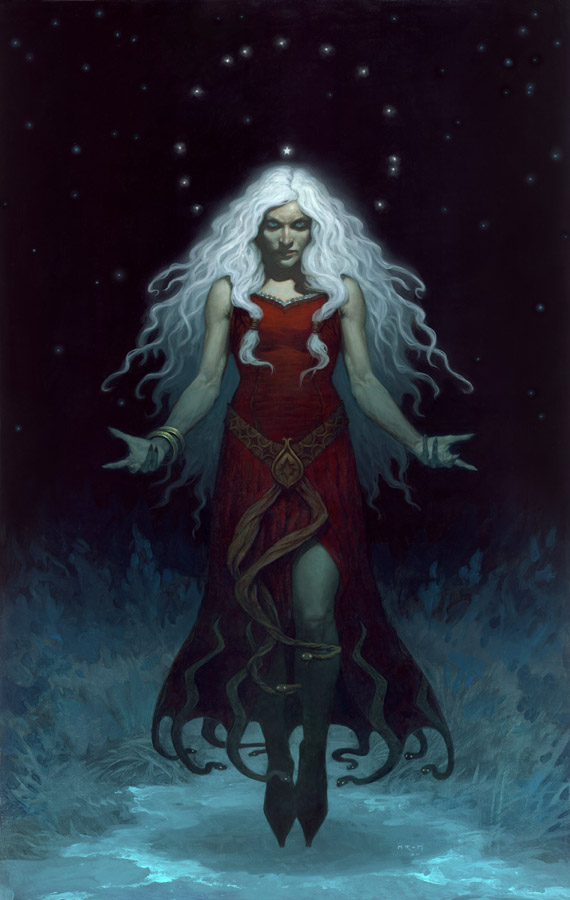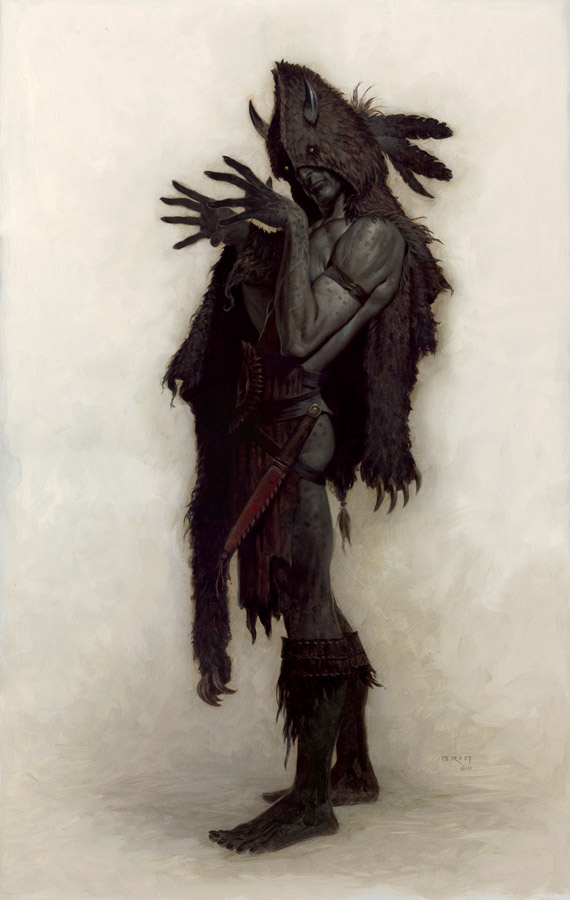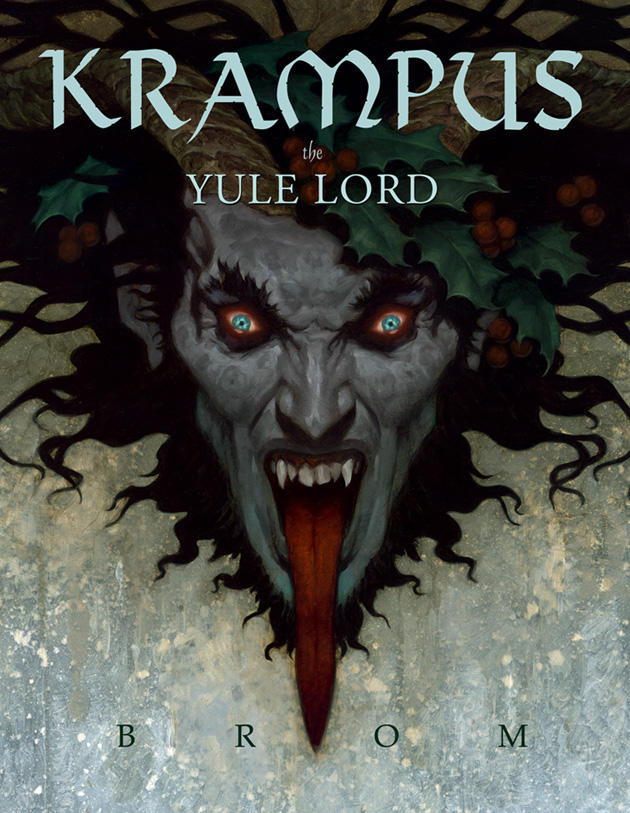He sees you when you’re sleeping. The Krampus that is. You all know who the Krampus is, right? That diabolical figure covered in black fur, with horns like a goat, cloven hooves and a long red tongue? You better watch out. The Krampus is the legendary Christmas counterpart to Saint Nicholas, who punishes the naughty children while Nick gives the good ones gifts. Sure, he didn’t really make the trip across the pond, but over in Europe he was and still is a popular part of the holiday season. You better not cry, you better not pout. The spooky figure dragging rusty chains who snatches up bad children, swatting the naughty with birch switches, stuffing the worst in his sack to carry off.
 He’s the central figure of the Krampuslaufen, when people dress up like devils, get drunk on schnapps, and run through town. This is the myth that artist-turned-author Brom decided to revitalize with the nice holiday story, Krampus: The Yule Lord. Weaving the folklore in with ethnography and more than a few very clever pieces of Norse mythology, he delivers a story that will make you a fan and celebrant of Krampusnacht and Yule. Gonna find out who’s naughty or nice.
He’s the central figure of the Krampuslaufen, when people dress up like devils, get drunk on schnapps, and run through town. This is the myth that artist-turned-author Brom decided to revitalize with the nice holiday story, Krampus: The Yule Lord. Weaving the folklore in with ethnography and more than a few very clever pieces of Norse mythology, he delivers a story that will make you a fan and celebrant of Krampusnacht and Yule. Gonna find out who’s naughty or nice.
I’ve liked Brom for a while now…in fact, I think I can tell you the year I became a fan of Brom: 1994. I had probably seen his work before then, but when I picked up the newest Shadowrun module, Harlequin’s Back, I knew I had to find out more about the cover artist. That moment there crystalized a broader awareness of how roleplaying books and roleplaying illustration exist in a symbiosis, a gestalt, and made me take active note of people like Tony DiTerlizzi and Larry MacDougall and to just start paying attention to who was putting those pictures next to the statistics and game mechanics.
The relationship between the pagan Yule traditions—at least, Brom’s version of them, which he talks about in more depth in the book’s appendix—and the Christian heritage of Santa Claus is at the root of the book, which deal with the appropriation of winter solstice rituals into Christianity on a fictionalized, supernatural level. Krampus begins chained, hidden away, a heathen creature forgotten, betrayed by Santa Claus, shoved under the rug in order to focus on a sanitized version of the former fertility festival. Locked up, the Krampus has plenty of time to focus on one thing: Revenge!

How the Norse mythology gets dragged into the book is actually really the brilliant bit. I suppose it is a bit of a spoiler, but again, since I just read Song of the Vikings, I sort of need to talk about it; you could skip this paragraph and the next, if you are concerned about remaining in the dark, but I don’t think it will ruin your enjoyment of the story if you don’t. Because the Germanic traditions of Yule are connected to Norse mythology, Brom draws two elegant lines, connecting both Krampus and Santa to the gods of Asgard. Krampus is the son of Hel, daughter of Loki, queen of the underworld. He is the Horned Lord, the revitalizer of the Earth when the dark of winter lays upon the land.

Now, the twist behind Santa Claus is the more contentious and cunning origin if you ask me. You know the story of Baldr the Brave, Baldr the Beautiful, Baldr the Best, beloved son of Odin and Frigg. Everything loved Baldr…except Loki. Because Baldr was so adored, everything in the world swore to his mother Frigg that it would never harm Baldr…except Frigg didn’t bother to get little old harmless mistletoe to agree. Add in Loki, the blind god Hoder, and as you’d expect…that sprig of mistletoe kills off Baldr. Chekhov’s Herb, if you will. Well, that ain’t all she wrote for Baldr; after Ragnarok, when everyone dies? He comes back to life…and that, my friends, is the secret origin of Santa Claus.

The biggest problem I have with Krampus is the same problem I have with a few other of Brom’s novels: the human element. I realize that the no-account young man who over the course of a novel learns an important lesson about standing up for himself is a major theme of literature. Heck, I realize that the Refusal of the Call is standard fare for the Campbellian Hero’s Journey, one of the mythic underpinnings of narrative. I just…don’t like the protagonist for the bulk of the book. Jesse’s just too sniveling, too full of self-loathing and self-doubt. I agree with the villains when they talk down to him; he deserves it! I don’t find the character likable, not for a long stretch of the book. Luckily, once the Krampus comes onto the page, he just chews up the scenery: Jesse’s pathetic but the Krampus is delightful.

What this book achieved, in the end, is something important, I think: it made me want to put out shoes for the Krampus to fill with gold coins. It made me want to get gelt, those chocolate gold coins, to put in other people’s shoes. The Krampus made me want to drink Schnaps—the German stuff, not the sugary American stuff—put on horns and run around in the snow. Ultimately, it made me want to participate in the holiday tradition of the Krampus, to put him side by side with Santa Claus and Rudolph and George Bailey and John McClane and the Doctor Who Christmas Special.

…he knows if you’ve been bad or good…so be good for goodness sake!
Mordicai Knode would also like to mention that this isn’t the first time The Horned Lord and Santa Claus have met: he highly recommends that you read Frank L. Baum’s The Life and Adventures of Santa Claus, and see the Rankin and Bass adaptation of it, too. You can follow Mordicai on Twitter and Tumblr.











Are there any Krampus songs out there in internet land? My wife has giant Christmas playlists, & a little Krampus would add to the holiday cheer!
This review mirrored my view… Krampus was a delight and I want to put my shoes out too.
Krampus is one of the songs in the album
Another Creepy Christmas Jonah Knight you can find it on line at Jonah’s website
2. Lon
Thanks Lon! It wasn’t a rhetorical question! I hope the Krampus comes this year…if you haven’t been naughty….
Oh!
A Krampus Carol by Anthony Bourdain
Krampus song/video.
http://www.youtube.com/watch?v=6EmqsEHl3P8
There was Venture Bros. episode with Krampus in.
http://video.adultswim.com/the-venture-bros/punishing-the-wicked.html